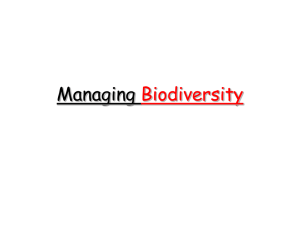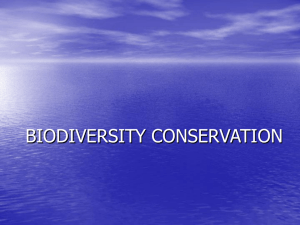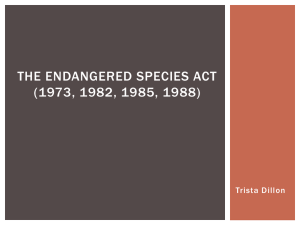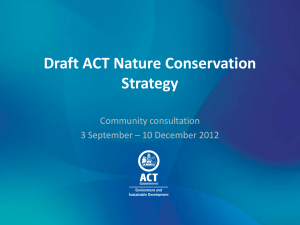Reality
advertisement
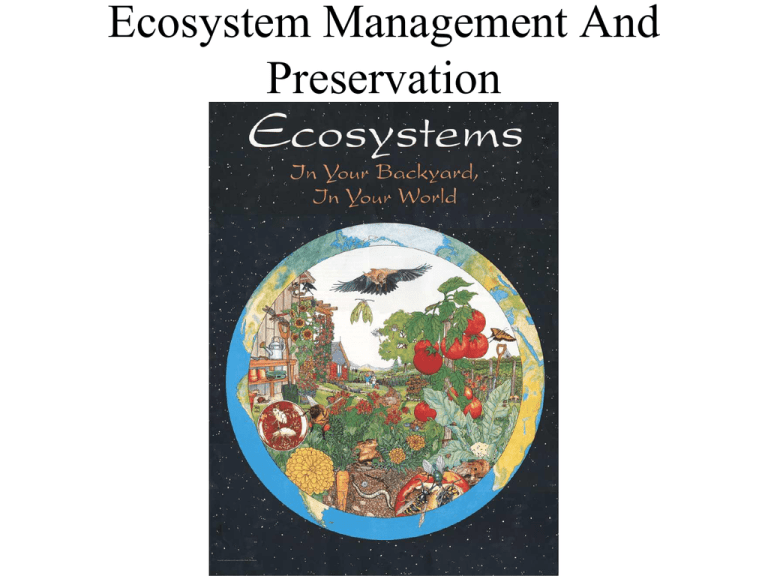
Ecosystem Management And Preservation Ecosystem Preservation – Boreal Forests, etc. Semi-Natural Ecosystems • Ecosystems that have been modified by some human activities such as logging, fishing and grazing but which are still dominated by native species Early Conservation Efforts • 3000 YA – Ikhnaton sets aside land for game preserve • Asoka – 272-232 BCE declared some animals can’t be killed, forests not burned Modern National Parks – Yellowstone N.P. - 1872 Hayden survey of Yellowstone – 1870 Yellowstone National Park – Army Bike Patrol Reserves • Reserves – any natural or semi-natural ecosystem that is protected from most forms of human use - however, we must remember that reserves go by several different names - national parks, refuges, national monuments, national wilderness areas, preserves and more; with many regional and local versions of reserves too Reserve Selection Reserves are developed by a variety of mechanisms: 1. Government action – usually at a national level, but may happen at regional or local level as well 2. Land purchases by private individuals and conservation organizations (such as The Nature Conservancy) 3. Actions of indigenous peoples and traditional societies 4. Development of biological field stations – usually combine biodiversity protection and research with education Grand Canyon Arctic National Wildlife Refuge Houston Toad The Nature Conservancy – active since 1951 in the US Nature Reserves Managed by native people – Arnheim land, Australia Biological field stations as Reserves Creating Preserves Creating new reserves requires the following steps: 1. Identifying priorities for conservation 2. Determining those areas of each country that should be protected to meet conservation priorities 3. Linking new protected areas to existing conservation networks, using techniques such as gap analysis Setting Priorities 1. Distinctiveness (or irrereplaceability) – an ecosystem that consists of primarily rare or endemic species or that has other unusual attributes (scenic value, geological features) is given highest priority 2. Endangerment (or vulnerability) – species in danger of extinction are of greater concern than those that are not 3. Utility – species that have present or potential value to people are given more conservation priority than species of no obvious use to people Distinctive Ecosystem – Peat Bogs Rarity – European Bison Utility – wild apple Kazakhstan Determining which areas should be protected 1. The Species Approach – focus on focal species (indicators, flagship or umbrella species) 2. The Ecosystem approach – save enough representatives of each ecosystem (at least 10%) can save most biodiversity 3. The Hotspot Approach – save areas that have high numbers of species – especially rare or endemic species Indicator species – Freshwater mussels Ecosystem Classification Ponderosa Pine Forest Hotspots Hot spots or centers of diversity – are areas with high levels of species diversity and usually also high levels of endemism – thus become key areas to preserve – at least 34 global hotspots have been identified 34 Biodiversity Hotspots 34 Biodiversity Hotspots Continental U.S. Biodiversity Hotspots Protected Areas in the U.S. Hotspots and Protected Areas in the U.S. Habitat Occupied and Reserves for Hawaiian Finches Hotspots on Mt. Mulanje, Malawi Rare and Endangered Species in the US • Andy Dobson examined the distributions of 900 rare and endangered species in the US and found: • 0.8 to 3.3 percent of the land in the lower 48 states provides habitat for just over 50% of the rare and endangered species • At risk reptiles and amphibians occupy 0.68% of US land; endangered fish take up the most space - 3.33 % • San Diego County, California is a hot spot for endangered fish, mammals and plants • Santa Cruz County, California is a hot spot for endangered arthropods, reptiles, amphibians, and plants • 4 counties in Hawaii are hot spots for endangered birds and plants Gap Analysis 1. 2. 3. 4. 5. 6. Data are compiled on the species, ecosystems and physical features of the region – sometimes referred to as conservation units or ecoregions Conservation goals are identified, such as amount of area to be protected for each ecosystem Existing conservation areas are reviewed to determine what is protected already and what is not (identifying the gaps) Additional areas are identified to help meet the conservation goals (filling the gaps) Additional areas are acquired for conservation and a management plan is developed and implemented The new protected areas are monitored and management plans adjusted Idaho Ecoregions – birth of GAP analysis Idaho – Western Juniper Shrubland General issues in reserve design – the 4 Rs • Representation – the protected area should contain as many aspects of biodiversity (populations, species, habitats, etc) as possible • Resiliency – protected areas must be sufficiently large to maintain all aspects of biodiversity in a healthy condition for the foreseeable future, including the predicted impacts of climate change • Redundancy – protected areas must include enough examples of each aspect of biodiversity to ensure its longterm existence in the face of future uncertainties • Reality – the must be sufficient funds and political will, not only to acquire and protect lands, but also to subsequently regulate and manage the protected areas More specific questions: • How large must a nature reserve be to effectively protect biodiversity? • Is it better to have a single large protected area or multiple smaller reserves? • How many individuals of an endangered species must be included in a protected area to prevent extinction of the species? • What is the best shape for a nature reserve? • When a network of protected areas is created, should the areas be close together or far apart? Should they be connected to each other or isolated from each other? The Fate of Island Reserves – How big is big enough? Thomas Lovejoy Minimum Critical Size Study Reserves Edge of Minimum Critical Size Study Reserves Basic Reserve Design 1. 2. 3. 4. 5. 6. Big reserve better than small One big better than several small in same habitat Closer is better than spread out Clustered is better than linear Having corridors is better than not Circular is better than other shapes Species losses in Western North American National Parks Grizzly Bear – Ursus arctos horribilus Australian Conservation Networks Alps to Atherton in east and Gondwana Link in southwest


